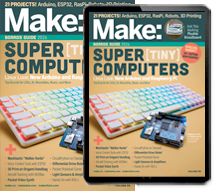x
Make:
Make: Magazine, Volume 24 - PDF
Shipping calculated at checkout.
Make: magazine, Volume 24 (PDF), the first magazine devoted to digital projects, hardware hacks, and D.I.Y. inspiration.
MAKE blasts into orbit and beyond with our DIY SPACE issue. Put your own satellite in orbit, launch a stratosphere balloon probe, and analyze galaxies for $20 with an easy spectrograph! We talk to the rocket mavericks reinventing the space industry, and renegade NASA hackers making smartphone robots and Lego satellites. Of course, as usual, we've got a full payload of other cool DIY projects, from a helium-balloon camera that's better than Google Earth, to an electromagnetic levitator that shoots aluminum rings, to a simple stroboscope that takes the most amazing freeze-frame photos. Plus: party-pleasing automated photo booth that prints out photo strips, MythBusters' Adam Savage teaches you hard-shell moldmaking, and much more.
See the "More Details" tab for the complete table of contents.
MAKE blasts into orbit and beyond with our DIY SPACE issue. Put your own satellite in orbit, launch a stratosphere balloon probe, and analyze galaxies for $20 with an easy spectrograph! We talk to the rocket mavericks reinventing the space industry, and renegade NASA hackers making smartphone robots and Lego satellites. Of course, as usual, we've got a full payload of other cool DIY projects, from a helium-balloon camera that's better than Google Earth, to an electromagnetic levitator that shoots aluminum rings, to a simple stroboscope that takes the most amazing freeze-frame photos. Plus: party-pleasing automated photo booth that prints out photo strips, MythBusters' Adam Savage teaches you hard-shell moldmaking, and much more.
See the "More Details" tab for the complete table of contents.


